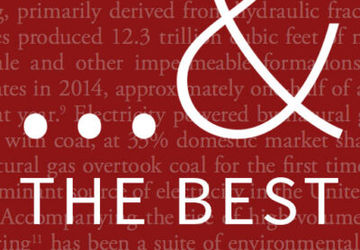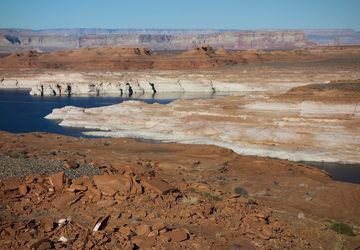Landauer provides an analysis of a few new works done by Lukas Felzmann, Lane Center affiliated photographer.
By Sasha Landauer
The bars of the cage lying in the grass and their shadows are effectively indistinguishable. The cage looks more like a musical instrument in the blurred grassy dreamscape of Felzmann’s image. One could imagine the bars to be strings, strummed by wind and passing animals. There is a feral undertone as the wild unfocused field encroaches on the object which already fades into a hallucinatory realm. The focus dissipates throughout the frame, leading the viewer to seek an axis of reflection. A fraction of the image shimmers like a memory—it’s difficult to tell whether it is a reflection or an extension of the whole. In is in this liminal space, between echo and entirety, that Felzmann brings his viewers to dwell and experience the porous nature of boundaries. His latest collection, tentatively named “A Conceptual Atlas of California,” dives into in-between spaces as he explores all 58 counties in the state, paying particular attention to the boundaries between the manmade and the natural.
Felzmann uses a specific kind of film camera called a view camera, which has bellows in the middle allowing him to vary the focus within the image. It was originally invented for maximum precision, but Felzmann said he started to use it to the opposite effect to leave much more up to subjective interpretation. In the absence of precise visual cues, the viewer is left either to strain for detail in the blur or dwell in dream-like unfocused space.
This unfocused disorientation reframes how viewers interact with objective geographic space. During an era in which landscapes are changing at unprecedented rates and technical maps no longer accurately reflect their settings, the practice of actively interpreting objective information is increasingly important. The scenes of Felzmann’s photos that fade out of focus ask the viewer to consider what they will remember when these landscapes dwindle and become unrecognizable. Thus, the idea of a conceptual atlas is one in which we must we don’t take for granted the objectivity of topography and make space for our individual associations and perceptions.
Felzmann’s photos encourage this association with topographic maps. They are saturated with contours—undulating pipes are bisected by telephone poles that don’t quite meet at right angles. Traditional markers of scale are nowhere to be found as many of his images just barely elude the horizon. Instead of a horizon we get a long pipe beyond which objects no longer obey traditional rules of relation. In the absence of a consistent reference point, distant trees appear to be at the same height as much taller telephone poles.
The bare sky with its flat clouds and shadowless ground gives us an atemporal glimpse of a nearly apocalyptic landscape. Neither the pipes nore the wires are connected to any productive structures implying abandonment. As in the prior examined photos, not only does this image explore the boundary of manmade and natural, but also inhabited and desolate. The only indicators of human life in Felzmann’s frames are quasi-permanent industrial structures. There is no hint of motion within the frame—all objects are in consistent focus, so the viewer’s gaze is not pulled in a specific direction.
The neat parallel dashed lines of the road fade before quite converging in our perspective. The cliff’s texture, appearing as though violently scratched, stands out in stark contrast to the measured white dashes of the road. The fact that none of the lines quite meet echoes the appearance of topographical maps in which lines reflecting elevation approach maximum density but never quite overlap. The topography of the road as compared to the cliff appear incommensurable. The two represent different velocities—the dashes of the road are built to carry us up as we face the optimistic turn of the bend. The grooves on the cliff were likely formed by water running down. These two clashing directions remain unresolved in the image—the blank guardrails prevent the viewer from seeing the intersection of road and cliff.
The shadows on the road, often a common sight, become mysterious and enigmatic when considered more closely. The spots of light on the road evoke dappled sunlight beneath a canopy of leaves yet appear to be formed by the solid cliff on the left of the frame. How could a dense chunk of rock let through patches of light? This incongruence of objects and their shadows inspires a sense that Felzmann caught the scene at its threshold just as objects and forces of physics themselves cease to behave as we might expect.
This image differs from the previous one by giving a multiplicity of horizons while still obscuring the natural one. The viewer is left measuring the asphalt road, near bank, water, far bank, distant hills, and broad empty sky. Each of these forms mark their own horizon—we see no intersections of asphalt giving way to muddy earth or water lapping at the bank. With no explicit image of these liminal spaces, the photo itself becomes ethereal. The water is so still that it is difficult to distinguish between that which is reflected and simply foregrounded. The permanence of three-dimensional objects is undermined through association with transitory reflections. The tenuous stillness of the frame and its uninterrupted waters lend the impression of a timeless moment, although the water might be on the brink of disruption.
The viewer is similarly asked to doubt their own perception as we strain but are unable to discern the exact objects in the darkness evoked by the high contrast banks. Just as the ambiguous lighting in the photo of pipes made it seem atemporal, the confounding of dimensionality in this image brings us to reconsider our notions of place. This subtle unraveling of time and space is crucial to Felzmann’s project, inspiring us to reconceptualize our relationship to the Atlas.
Read more at the Out West Student Blog »








